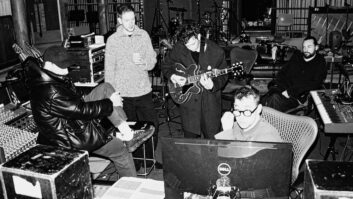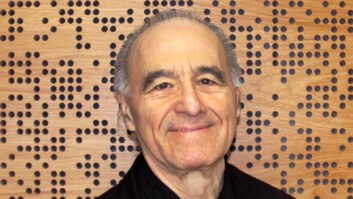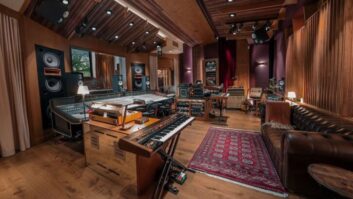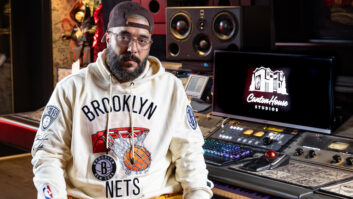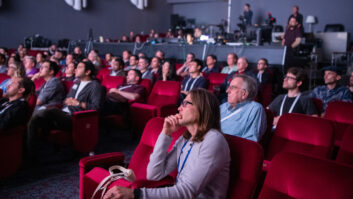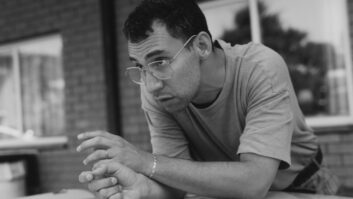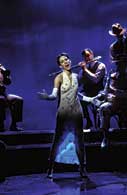
Sheryl Crow sings “Begin the Beguine” as a cast member of Cole Porter’s Broadway musical, Jubilee, in De-Lovely.
Photo: Simon Mein
Martinis, cigarettes and tinkling pianos. Witty lyrics, clever melodies, high society and Broadway: Even today, the name Cole Porter evokes images of a particularly romantic and sophisticated lifestyle. A prolific composer from the late ’20s to the 1950s, Porter was unmatched as a tunesmith, with a legacy of songs that are still admired and performed.
In the stylish musical film De-Lovely, Porter, played by Kevin Kline, looks back on his life as if it were one of his elaborate stage shows. Set against the background of such classic Porter hits as “Anything Goes,” “Night and Day,” “Begin the Beguine” and — naturally — “It’s De-Lovely,” the film moves back and forth in time, enhanced by a soundtrack that supports its numerous layers, montages and transitions. The music is paramount, juxtaposing simple songwriting sessions with large production numbers — and an abundance of pianos.
De-Lovely‘s soundtrack is complicated and subtle. Visuals and sound constantly switch back and forth between different settings and different eras. Add to that director Irwin Winkler’s penchant for live sound and a slew of cameo production numbers, featuring such high-profile singers as Elvis Costello, Sheryl Crow, Diana Krall, Alanis Morissette, Natalie Cole and Robbie Williams.
Mix dropped in on the final mix on Stage 2 at Todd-AO’s Lantana Center in Santa Monica, Calif., to visit with some of the team: supervising sound editor/dialog and music mixer John Ross, arranger/music producer Stephen Endelman, music editor Christopher Kennedy and sound effects mixer Michael Keller.
Fueled by pizza, the sound crew for De-Lovely came together at the Euphonix System 5 on the Todd-AO West stage: (L-R) Jason Barnowski, Walter Spencer, Rob Cowen, Christopher Kennedy, Michael Keller, Stephen Endelman, Charles Winkler, Irwin Winkler and John Ross.
SUBTLE SOUNDS
“The interior of the Wallace Theater serves as a staging ground for the film’s action,” explains Ross, an industry vet known for his work on such films as American History X, Austin Powers, Lost Highway, Blade II and The Butterfly Effect. “A scene might begin there with Cole playing piano and then venture off into different eras of his life using different mechanisms to travel backward and forward in time. Because of that, we had to design a very nebulous soundtrack that was basically nonlocational. For example, we’ll have a hint of traffic with some background sounds that are identifiable as New York City. But instead of being specifically ‘period,’ they can’t be recognized as either modern or old.
“The sound of the theater itself is sort of hollow,” he continues, “with a continuously echoing atonal pulse, the kind of thing that would be generated by piping systems and the distant, muffled city and traffic sounds. We filtered out anything that would signify period — sirens or cars — to ultimately suggest the interior ambience of a theater anywhere from the 1900s to the 1950s.”
“All of the locations have a very distinct sound,” adds sound effects mixer Michael Keller. “The theater is a timeless, isolated capsule, acting as a kind of bridge between the past and the present.”
According to Keller, the balance between ambience and dialog was a delicate one, especially during scene transitions. “We had to listen to the dialog during predubbing,” he explains, “because there were so many pre- and post-laps, where the visuals had already cut to the new time period but the dialog remained in the past. Our backgrounds had to shift with the cue of the dialog and not necessarily with the picture.”
The murmur of an audience before the curtain rises, the rustle as a page of sheet music is turned, the click of a lighter: For De-Lovely, small details often dominated. “For the most part, the work on this picture was very subtle,” Ross comments. “In some of the scenes, the sound sculpture as a background had to be very still. It’s about the performance and the characters, so we had to build little moments that were very deliberate and staged. We’re selling the presence of the actors, but we can’t be large or over-the-top. We just have to be felt.”
To that end, the crew relied in large part on production sound recorded by Tim Fraser. Keller estimates that approximately 90 percent of De-Lovely‘s effects were PFX. “We had really clean stereo production effects,” he comments, “especially in the dance scenes, which are big musical or tap dancing numbers. Having that many channels of production sound is kind of unheard of; it was certainly a first for me. Normally, we have just two or three tracks that a dialog mixer provides during his predubs.”
“There are a lot of goodies in production if you go looking,” says Ross. “We got the code book — the picture editors’ bible — so we could look though alternate takes of a particular scene. In particular, we were looking for things related to the actors: pieces of movements, exhalations, production elements we could use to build up a scene.”
SCORE AND SONG
For New York-based composer Stephen Endelman, De-Lovely was also an unusual project. As music arranger and producer, he supervised the cameo vocal recordings, most of which were done at Air Lyndhurst Studios in London (with several recorded at New York’s Avatar and Sony Music Studios).
“For each arrangement,” he explains, “there was a slightly different setup of instruments. For example, for Natalie Cole’s song, ‘Every Time We Say Goodbye,’ we had a string quartet, piano and flügelhorn. For Caroline O’Connor’s version of ‘Anything Goes,’ there was a big band sound with a lot of brass.”
Each song, recorded by Endelman’s longtime engineer Philip Bodger, took a day to complete. Tracks were laid to analog multitrack tape and then transferred to Pro Tools for editing and overdubs. Final mixing, also by Bodger, took place at Sony in New York. “We recorded the rhythm sections in the morning, along with a basic guide vocal from the artist,” recalls Endelman. “The artist would come back in the late afternoon to do their vocal and then we’d do temp mixes that would be used for the shooting. The only variation in that way of working was with Natalie Cole, who was truly amazing. We had a packed control room with people who’d come in from Air Lyndhurst’s other studios just to hear her. She sang it down four times with the band and that was it.”
As Cole Porter, Kline played and sang the bulk of his numbers live on the set. “Kevin wanted to do most of his parts live for the feel, and he did a very good job,” says Ross. “His performances fit well with the character of Cole Porter, but that meant a lot of singing into a radio mic. There was also a lot of studio piano work, so we ended up with a lot of different pianos.”
Live recording of the pianos was to a 4-track Zaxcom Deva. Camera demands ruled out booms, so for the most part, hidden wireless mics had to suffice, often resulting in a piano sound that was mono and, due to placement issues, not always optimal. Studio pianos were recorded in California, London and New York with different players. It was Ross’ job to match them up. “For the most part,” he says, “I ended up making a compromise between the width and the roundness of the production pianos and the scale and size of the studio pianos. Sometimes the studio piano had to be a little smaller and less full-frequency to marry the two together. Room reverb helped, as well as EQ to blend the two.”
“It was an extraordinarily complex film,” says music editor Kennedy, whose work on the project was largely done from his home studio in Pennsylvania. “The most important thing for me was to ensure that the editor’s cut remained in perfect sync with the original playback track. The picture editor, who was on the show long before me, was using a live guide track recorded on set so that she could use the inherent ambience to make the cut scenes sound more realistic. That worked well for the most part, but there were some occasions when, due to clocking problems on the set, a particular track didn’t match the length of the original playback track. On top of that, during the extensive editing process, some cuts would go awry and end up out of sync. It was my responsibility to make sure that every shot in the film was in sync in the final cut.
“In some cases, the musical scenes had lengthy dialog sequences cut into the middle, requiring additional refrains to be added. I had to work very closely with the picture editor to ensure the rhythmic continuity of the music. The challenge was to take the multitracks and switch the instrumentation around so it didn’t sound as if I were looping the same section over and over behind the dialog.”
“One of the areas where we were very successful,” remarks Endelman, “was that we had very few sync issues; we were able to keep sync the whole time. We sorted through the timecode wars at the beginning so that everyone was on the same page from day one.
“Also, the amount of organization that we were able to do from the very beginning was enormously helpful. The artists were all aware of what they were going to be doing, so they were all prepared. Considering that we had something like 68 musical starts, all in different keys and tempos, and all music that’s very difficult to use a click with, the preparation that we did was invaluable. It came together very fast in terms of what we wanted to do with the tempos and arrangements and was quite synchronistic, which is pretty amazing when you consider how easily this all could have gone south!”
Nuendo Arrives on the Dub Stage
For recording and playback on the De-Lovely dub stage, supervising sound editor/dialog and music mixer John Ross put together a total of five systems based on Steinberg’s Nuendo Version 2.0. The playback system that fed 168 channels of predubs to Stage 2’s Euphonix System 5 console comprised three dual-processor Athlon 2800 CPUs running on Tyan server motherboards with MADI and UAD1 DSP cards and two channels of SCSI 320; Matrox Perhelia cards drove the video monitors. A fourth Nuendo system was used for playback of digital video, and a fifth system, hooked up via Ethernet, was used for stage support, with editor Walter Spencer able to access raw material such as dailies and sound effects libraries.
“With Nuendo, you can build a system that has tremendous track counts,” Ross comments. “And with the MADI interface, it’s very easy to integrate with the console. Literally, everything we’re hearing on the stage is hooked up to the core of the System 5 by just four BNC connectors. We’re also running digital video that looks phenomenal.
“Because Nuendo uses a lot of the architecture in the host environment, it’s all quite efficient,” he continues. “Other workstations would require much more DSP power to do the same thing. Although I have the Nuendo systems running on high-end server machines, they’re still essentially stock Windows XP machines. Steinberg’s ASIO open architecture allows you to build systems that live within a computer environment with incredible input/output options. You can build enormously powerful systems in a small footprint.”
On the dub stage, Ross, depending on the application, reached for both console and Nuendo functions. “The System 5 is, obviously, a very powerful console. The way I’m working with both it and Nuendo is to use the console in its more global scope to solve problems. It’s the big lever and Nuendo is the tweezer.
“Nuendo is particularly useful for things like volume mapping. For example, where a piece of production sound we want to use gets too loud, I can go in and map it down. Because the volume graph is superimposed over the waveform, I can do minuscule volume moves that allow the sound to become far more intelligible. Or when someone turns his head off-mic, I can chase the sound very precisely with the built-in EQ.
“What’s really great about all this,” he concludes, “is that you can design very complex systems to your own specs, scaled to whatever size you wish. The tools are maturing now so that we don’t need to work within a monolithic environment. Instead, we can democratize the process and build systems really customized to our needs. I find that a very exciting prospect.”

